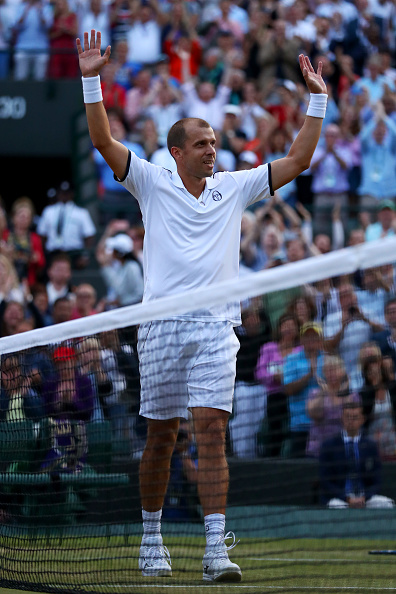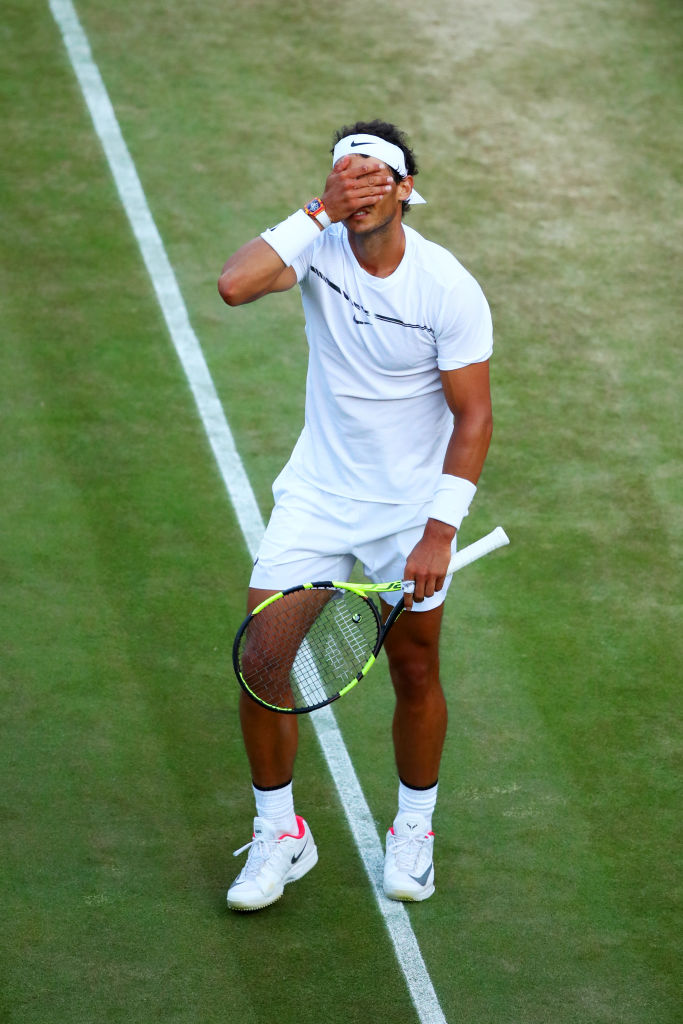Wimbledon –
Bill Simons
Certain things were clear. Rafa Nadal was in a zone. He hadn’t lost a Grand Slam set since the last excruciating set of the Aussie Open. He’d reached the finals at Indian Wells and Miami, and at the French Open he wrote history as he collected his record 10th Roland Garros. And If he could reach the Wimbledon final – a “doable” task – he would become No. 1. Just after Federer, he was favored to win here.
After all, more than any other claymeister, Nadal embraces grass and accepts its challenges with skill and enthusiasm. He loves to remind skeptics that he reached the semifinals of the Wimbledon juniors. He tells historians that his most emotional moment came when he beat Federer in the greatest match of all time – the 2008 Wimbledon final.
Still, truth be told, despite winning two Wimbledon crowns, grass is his “off surface.” In recent years he’s suffered losses to grass court savants like Lukas Rosol, Dustin Brown and Nick Kyrgios. And again today he would face a big man from a little country. He would have to be at his best against Gilles Muller. Okay, the only player from Luxembourg to ever compete in a Grand Slam was “only” ranked No. 26. The 34-year old veteran had a losing record in Grand Slams, he was mired in a dreary 22-match losing streak against top-five players, and in six meetings with Nadal he’d won just once. That had come at Wimbledon – but it was 12 years ago.
Fair enough, but no one wants to face Muller on grass. He reached the fourth round here just last year. At 6’4″, he is one dangerous grass court player. As a lefty, he can punish Rafa’s backhand, and now he’s a wily veteran who no longer gets down on himself. With a stunning 10-1 record, he has the most wins on grass this year.
And today, on Manic Monday, he came out with a performance which – for Rafa fans – was absolutely maniacal, as he took advantage of Rafa’s few lapses and used all his tools to baffle the Spaniard and boss him about the court. Muller took a two-set 6-3, 6-4 lead. “How shocking,” you say. Yes, we agree. But then again, maybe not. At Wimbledon, big grass court specialists always seem to lurk in hopes of grabbing glory. You can never count them out.
Then again, more than any tennis player on earth, it’s never a good idea to count out Señor Nadal – the fiercest fighter our game has. So, almost on cue, the Mallorcan locked in and began to march back into the fray, collecting the third and fourth sets with captivating play and an almost scripted certainty.
Ultimately the fourth-round battle came down to a decisive fifth set. Presumably, with his serve slowing and having lost two straight sets, Muller would get the message that he was playing the royal battler Nadal, and would, as the French say, crever – he’d burst.
Wrong.
*********
Rafa is a bull. And in bullfighting there is a term – querencia -– which means a bull inevitably returns to the part of the bullring where he’s most comfortable. And Rafa at heart is a clay court player who inevitably paced back eight yards behind the baseline to return serve. And this was a key in this instant classic that evoked memories. Like any Wimbledon marathon it immediately brought to mind the 2010 Isner-Mahut (70-68) battle. And like any match that is played into the London dusk, it suggested Nadal’s win over Federer in 2008 in the shadows. But at its heart this was a battle between the best clay court magician in history and a fine grass court player.
The 6’4″ Muller served with power and placement. He moved forward. He volleyed with confidence. He rarely blinked. Rafa stayed true to his roots. His will oozed intention. But it seemed like he was returning serve from Luxembourg. He camped out at the baseline. Then, at a critical moment, his (so true on clay) instincts betrayed him. He foolishly charged and was passed with punishing ease.
The fifth set had a simple, almost drone-like pattern that repeated itself with an odd regularity – can you say deja vu? In his element, and serving first in the final set, Muller repeatedly held with an almost breathless ease. Then Nadal, the bruising battler, would scramble to hold and even the score. The Spaniard was continually on the ropes, but Muller couldn’t finish him off. Six times Muller was two points from victory. Rafa would have loved to dictate as he does on clay. But that was out of the question. Worse yet, the man who craves order was coping with disorder. The match had none of the rhythm that is Nadal’s oxygen. Deep in the fifth, Rafa was left without any challenges. What’s a guy gonna do? Rafa even complained of random reflections coming from the stands. When down 5-4, the man even double-faulted. “Oh-my-god, oh-my-god, oh-my-god,” the silver-haired veteran reporter next to me whispered. “I never, ever thought I would see that from Rafa.”
But today it was something you couldn’t really see that proved decisive – scoreboard pressure. Playing from behind, Rafa knew, as the match stretched long and the shadows grew deep, that just one miscue would do him in. Still, four times he survived match point, until the final merciless blow came.
After 4 hours, 47 minutes, one of the greatest fourth-round matches in history finally ended ignominiously, when the man with one of the greatest forehands in tennis shanked a simple rally forehand. The gasp of the crowd was heard around the tennis world. Nadal fell 6-3, 6-4, 3-6, 4-6, 15-13.
Tennis wonks might argue whether indeed this was the greatest fourth-round match in history. (Jimmy Connors’ 1991 US Open win over Aaron Krickstein and Michael Chang’s 1989 French Open dismantling of Ivan Lendl come to mind.) Plus, historians might debate whether this was the best match ever played on Court One. (I think it was better than the 2015 Djokovic vs. Kevin Anderson classic, or Stan Wawrinka’s 2015 win over Richard Gasquet.) But fans in rowdy London pubs or clubhouses in leafy country clubs would not be arguing who is the greatest player of all time. That debate remains on hold. After all, The Mighty Rafa had fallen and suffered one of the most painful defeats of his career – in the very same London twilight where, almost a decade ago, he scored his greatest triumph.




















